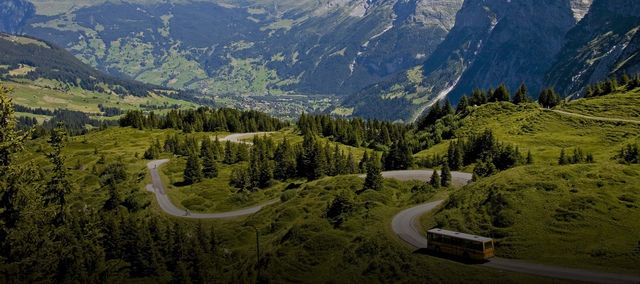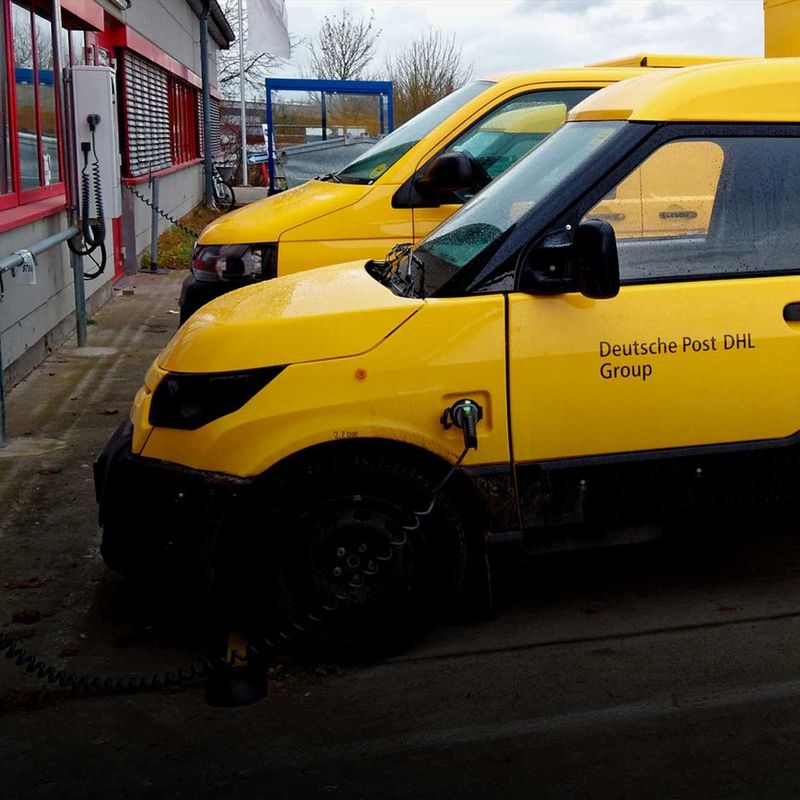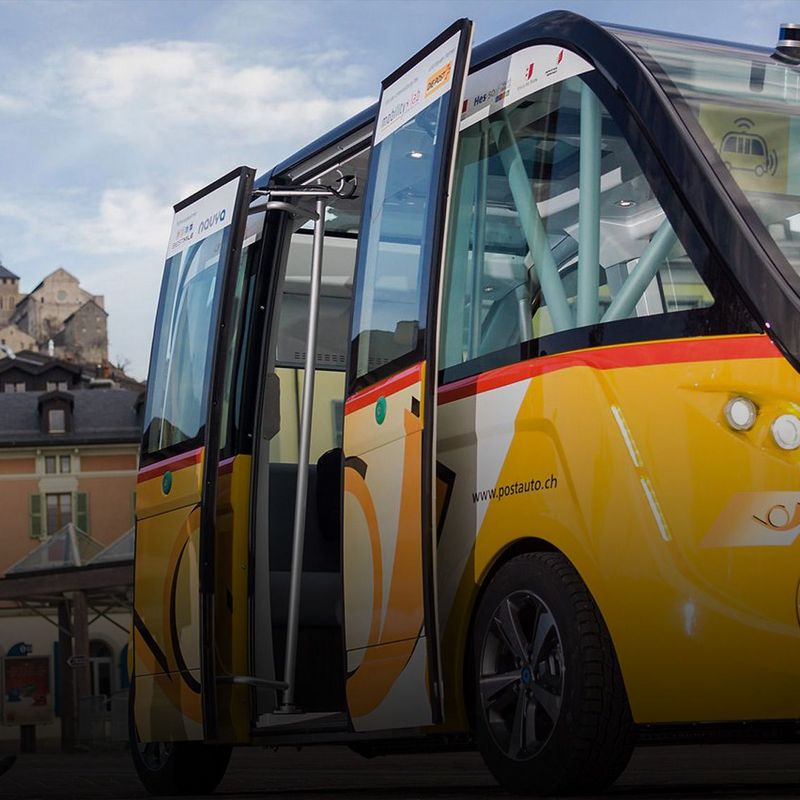18 October 2018
People who live in the country and cannot afford a car, or are simply too young or too old to drive, are faced with a problem. For public transport is usually infrequent and routes are limited. Local authorities and public transport providers are therefore trying different approaches so that those without their own cars can also get where they need to go.
Today’s city dwellers have ever more ways of getting around without actually owning a car themselves ... using the tram or metro, using bike or moped sharing schemes to go to work and car sharing for the weekend shop or a trip into the country on Sunday. But for those who live permanently in the countryside and cannot drive or do not have a car, the situation is very different and much harder. It may be that the bus only goes to the nearest large town twice a day, and that it is timed to fit in with school hours. The link with the outside world is more or less broken at weekends and during the school holidays. And this is a problem that is worsening with demographic change, as increasing numbers of young people are moving to towns and cities whilst older citizens remain in country areas.
In fact all this is happening at the same time as the need for mobility in the countryside is growing. Corner shops and pubs are having to close, country doctors find it hard to attract successors, and supermarkets, banks, post offices and official authorities have long been concentrated in regional centres. There are no easy solutions to the mobility problems in the countryside. “The regions and the needs of the people who live there are just too varied”, says environmental scientist Melanie Herget, expert on rural mobility at the Innovation Center for Mobility and Societal Change (InnoZ) in Berlin. In order to improve the mobility of their citizens and slow down the flight from the countryside, local authorities are therefore trying out different approaches – for example by adding new bus routes to the existing network or transforming fixed bus routes and schedules into need-based public transport. Instead of keeping to fixed departure times, local residents can then order an “on-demand bus” by phone. All they have to do is register their journey at the call center of a passenger transport company one or two hours before they want to set off. With this system is not possible to decide spontaneously to visit a local supermarket, but normal buses do not offer that either.
A bus when needed
In contrast to a scheduled service, the on-demand bus only drives to those bus stops which have been specifically requested – including stops which are normally not included in the route. Or it travels through villages where previously there were no buses at all. For transport users this means shorter distances to reach the bus stops or even the only chance to visit the doctor or supermarket in the nearest small town without independent car ownership. The local transport companies have fewer empty journeys, because only those journeys take place which are ordered beforehand. The bus or minibus passengers pay the normal price with a small supplement for convenience. But still their journey is considerably less expensive than it would be by taxi.
But it takes some time until the offering is fully understood and used by the local population, and local authorities often have to be patient. As an example, the small town of Wittlich in the Eifel registered a generally positive initial outcome after around one year of trial operation. In October 2016 there were 243 people using the on-demand bus, which calls at around 70 locations in the main town of the district. But in November 2017 there were already 445 users. Demand will have to rise even more if the system is to be fully utilised and the local authority is able to reduce its subsidy of 20 euros per journey. One way forward is to use digital technology: the “Wittlich Shuttle” can now be ordered by means of an App.
For flexible travel ... tap the App
In the town of Freyung in Lower Bavaria, matters are being taken one step further. The shuttle service which was launched there at the beginning of August 2018 has been named “freedom travel” (freYfahrt) and manages without any kind of timetable or actual bus stops. When the shuttle is ordered via a smart phone, the App navigates the passenger to one of a total of 230 stopping points. These virtual bus stops should not be more than 200 metres away from the front door of the user.
The “freYfahrt” scheme itself is operated by the town of Freyung and the local bus company, whilst the Berlin start-up company “door2door” is responsible for the digital infrastructure which intelligently bundles the routes of the passengers in the background. The pilot phase was intended to start as early as autumn 2017, but the legal obstacles were more serious than was at first imagined. According to Melanie Herget, the fact that it often takes so long to put innovative transport solutions onto the road, even if local authorities want them in the public interest, is the result of antiquated passenger transportation law. “Many parts of the legislation originate from the 1930s, from a completely different world”, says Melanie, the expert from InnoZ. New schemes which do not fit into the fixed categories of scheduled public transport, hired cars or taxis may only be tested for a maximum of four years based on an “experiment” clause. After this period, the current legal situation requires that the experiment has to end – whether it was successful or not. “There really is a need for reform here”, concludes Melanie. “We need freedom to experiment. And if the experiments prove successful based on social, ecological and economic criteria, it has to be possible to bring them into regular operation.”
On the horizon – “autonomous buses”
The on-demand bus system in the rural district of Neumarkt in Bavaria is already considered a successful model. Since 2011, the bus has been making its way through 17 parishes. In 2015 the number of users climbed from 25,000 to 28,000, and in 2017 there were already 39,000 passengers on board. The local authority traffic planners are setting their hopes on the next quantum leap of technology. “When autonomous driving – in other words driverless buses – arrives on the scene, it will be possible to extend our offering without added cost”, explains Michael Gottschalk – responsible for district development at the rural district authority in Neumarkt – to the Donaukurier newspaper.
Roboterbusse – die Revolution für den öffentlichen Nahverkehr?Driverless buses are being tried out already ... for example in the Bavarian town of Bad Birnbach. But as mobility expert Melanie emphasises, before they can travel on the roads in the normal way and without a “safety driver”, ethical and legal questions still have to be clarified. The benefits of the robot buses for mobility in the countryside are obvious to environmental scientist Melanie. For the driver’s salary, as 60 to 70 per cent of the whole, accounts for the lion’s share of costs for transport providers in rural regions. This means that most on-demand minibuses are in principle more expensive than traditional scheduled buses. For a driver can potentially transport around 40 passengers in a scheduled bus, but the small shuttles allow only nine passengers per driver.
Back to the stagecoach
In order to utilise currently uneconomic bus routes more effectively instead of closing them down, local authorities are returning to old ideas. The principle behind so-called combibuses is “back to the stagecoach”. In the same way as the horse-drawn multifunctional vehicles of the past, combined-use buses transport both goods and people to their destinations. In regionally-based nations, such as Finland, multipurpose vehicles have been used successfully for decades. And since 2012, combibuses have been used on scheduled routes in the sparsely populated region of Uckermark in northeastern Germany. These can supply farm shops and restaurants with products from a regional cheese dairy, for example, or deliver small volumes of material to tradesmen where use of a traditional haulage company would not be worthwhile. However, in contrast to Scandinavia, vehicles which are a combination of bus and truck are not used in Uckermark, because the country buses already used in scheduled operation have sufficient storage space. However, there is still a long way to go in order to match the current situation in Scandinavia, where goods transportation contributes up to 25 per cent of turnover. The combibuses in Uckermark have to date not even reached one per cent of turnover attributable to transportation of goods, as the CEO of the Uckermärkische Verkehrsgesellschaft (UVG) transport company, Lars Boehme, explains to the Mittelbayrische Zeitung newspaper. Use of this model is growing, but slowly. Previously, it was mostly trade customers who used the service, but since September 2018 normal residents can also use the buses to have boxes of food delivered – potentially right to their own front door.
If people can no longer travel to the supermarket, the supermarket has to come to the people: based on this principle, other projects, initiatives and providers are trying to meet the needs of local people by providing mobile services. From the doctor’s surgery on wheels in Hessen through travelling cinemas in Uckermark and Baden-Württemberg up to mobile banks in Saxony. And the German post office also recently launched their countryside post office (Meine Landpost) pilot project: this features a service van which is intended to act as a corner shop and supply the residents of two parishes in Bavaria and Baden-Württemberg with packages, stamps – and also body lotion, fruit and pea soup. Services like these are particularly useful for older residents – although they are obviously unable to replace traditional doctors’ surgeries or supermarkets.
Scheduled routes reloaded
And this is why for Melanie Herget, mobility in the countryside stands and falls with expansion of traditional scheduled bus routes. In order to achieve this, buses and their financing must be less dependent on transportation of schoolchildren, which is subsidised by the federal state, and at 70 to 80 per cent accounts for the majority of public transport in rural areas. It results in a low number of journeys and bus routes that show little relation to the needs of the rest of the population. This is because the buses pass through the most remote villages on their way to the nearest district town in order to pick up the very last pupils. “This leads to extremely long journey times which make bus travel unattractive for all other potential users”, explains Melanie. Therefore it is important to focus on the main transport routes used by the people in a particular region. “We then have to establish a regular schedule on these routes. And at least once an hour, because that is what people are able to remember.”
The problem: public transport has up to now been the responsibility of the local authorities and the regions. And in general these are simply unable to afford a dense network of routes – and from the legal point of view they are also not permitted to work outside their regional boundaries. “I therefore think it is very important for the states to take greater responsibility”, says InnoZ environmental scientist Melanie. And a start has already been made: in Saxony-Anhalt, Lower Saxony and Baden-Württemberg, buses which cross regional borders are funded by the states. And in 2017 Thuringia also started to establish bus routes which are considered important for the state as a whole. Fourteen routes have now been approved, and more are to follow. They are intended to close the gap between regional centers which are not directly linked by train. Based on the high frequency and speed of the buses, car drivers should also be persuaded to leave their cars at home.
However, according to Melanie, economic feasibility should not be the only factor when evaluating if investment in local transport for the countryside is worthwhile. “Without mobility, people move away from rural areas – and each person who leaves a region generates much higher costs than if the decision is actually made to provide money for mobility solutions.”
In the second part of our mini series you can read how people can achieve greater mobility using buses run by volunteers and special benches where people can sit to show they would like a lift. Soon on #explore.
You may also like
ABOUT
© Melanie Herget
Melanie Herget is an environmental scientist and mobility expert at the Innovation Center for Mobility and Societal Change (InnoZ) in Berlin.



